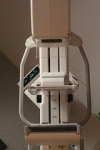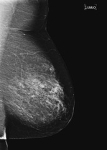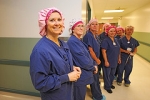A Guide To Your Breasts (For All Ages)
Women have a complex relationship with their breasts. We check them out to see if they look good in a certain sweater or a favourite tee shirt, and we search, often in vain, for the bathing suit that makes them look their best. It is also important to keep track of our breast’s appearance for health reasons, such as the possibility of breast cancer. This is an ongoing commitment, given that they change significantly from girlhood through pregnancy, on to menopause and beyond. Here’s a guide to being on familiar terms with your breasts at all ages.

The Teens And Twenties:
What Is Going On: This is a time of continuous change. You may have aches and pains that are a normal part of breast development.
When To See A Doctor: A rash on the breasts, swelling, or tenderness can signal infection. A discharge also can mean infection or can be side effect of birth control pills or antidepressants. Growth of hair around nipples is normal, but if the root gets infected, red bumps known as folliculitis may appear.
Healthy Tips: Start breast self-exams Get moving. Young women who average 3.25 hours of running or 13 hours of walking a month reduce their risk of breast cancer before menopause by 23 percent. Swap junk food for a healthy and nutritious diet loaded with fruits and vegetables – all food rich in antioxidants – known cancer fighters. Avoid cigarettes. Smoking damages collagen and elastin in both skin and breast tissue, causing your breasts to sag much earlier. It also increases your breast cancer risk. Studies show that passive smoking is also harmful and increases breast cancer risk by 70 percent in younger, primarily pre-menopausal women. If you’re contemplating breast enhancement surgery, don’t rush it. Your breasts may not have reached their full shape or size until your mid-20s, so you want to see what nature has given you first. Implants can also make mammograms more difficult to read.

The Thirties:
What Is Going On: You may see some drooping now, but it shouldn’t be anything major. While breasts don’t have muscle tissue they do get support from ligaments. Gravity, weight, and excessive bouncing all contribute to the elongating of these ligaments. Pregnancy creates whole new changes. During pregnancy, it’s normal for breasts to increase three times their normal size. From age 35 on, breasts may become smaller as shrinkage of the milk glands occurs.
When To See A Doctor: if you have a family history of breast cancer, talk to your family doctor about genetic testing. Most inherited forms are associated with abnormalities in two genes (BRCA1 and BRCA2) which account for 5 to 10 percent of all breast cancer cases. If you take birth control pills, discuss their use with your doctor. Women with inherited mutations of the breast cancer gene BRCA1 have a 20 percent higher risk of breast cancer if they take birth control pills. Those with the BRCA2 mutation don’t share this risk.
Healthy Tips: Talk to your doctor about screening mammography 10 years before their diagnosis. Breastfeeding is good for babies, and it reduces your risk of breast cancer. Activities that strengthen your chest and core, such as most forms of yoga help keep breasts looking youthful. Wear a jog bra during exercise. A British study showed that it increases comfort and decreases the chances of premature sagging.

The Fourties:
What Is Going On: With pregnancy and breastfeeding mostly a memory, breasts may be on a downward trajectory. That’s normal, if unwelcome. Although your likelihood of developing breast cancer is still relatively low, your risk starts to rise significantly after age 40. That’s why 40 is the age to start annual mammogram.
When To See A Doctor: If your quality of life is suffering due to menopausal symptoms such as hot flushes, discuss solutions with your doctor. Only consider hormone replacement therapy if other methods don’t work, because the therapy increases breast cancer risk by five to six percent for each year of use.
Healthy Tips: Go digital. According to the National Cancer Institute, US, digital mammogram pick up more cases of cancer in women who are pre menopausal, perimenopausal, have dense breasts, or are younger than 50. Don’t skip your annual (or half-yearly) mammogram just because your health insurance policy does not cover it. Remember, prevention is better than cure and it’s better to pay for those expensive mammograms rather than suffer due to late detection. Take calcium and vitamin D. Consuming more of both reduces risks of pre-menopausal breast cancer. Strive for 800 IU of vitamin D and 1,200 milligrams of calcium daily. Exercise can’t change the size of your breasts but it can change their appearance. When you strengthen the musculature beneath your breasts you will notice a nice lift and firmness.

The Fifties:
What Is Going On: Its normal to lose some tone and firmness in your 50’s (which actually makes a mammogram easier to read). Let your doctor know if you are still taking HRT or birth control pills, which can cause your breasts to become denser.
When To See A Doctor: Close to 80 percent of women diagnosed with breast cancer are 50 or older, so this begins an era of extra vigilance. Any change, even thickening of tissue in the breast, should send you to the doctor. A relatively rare but highly aggressive form of breast cancer known as inflammatory breast cancer appears as a redness or swelling that may come and go and involve all or part of the breast. Its texture may resemble the dimpled outside of an orange and feels warm to the touch. The average age of diagnosis is 59, earlier than other types of breast cancer. Left untreated, it can be fatal in a matter of months.
Healthy Tips: A daily aspirin may reduce the risk of one common type of breast cancer, estrogen receptor-positive, by 16 percent. Not everyone should take aspirin, as ask your doctor. Keep an eye on the scale.

The Sixties And Beyond:
What Is Going On: Sagging continues and you may notice your breasts beginning to flatten so that you need to be refitted for more support in your bra. The chances of a breast diagnosis are higher now because as we grow older it’s more likely that abnormal changes will take place in our cells. Since you are now in the highest risk group for getting a cancer diagnosis, it’s more important than ever to watch what you eat. A diet high in saturated and trans fat is a recipe for disaster since fat stimulates the production of the hormone estrogen needed for tumours to grow (even after the ovaries have stopped producing it). And stay active by doing the things you love such as gardening, cycling, or walking. It all counts towards prevention.
When To See A Doctor: If you experience depression, you must seek treatment. Research suggests that depressed breast cancer patients are over twice as likely to develop post-traumatic stress disorder than non-depressed people.
Healthy Tips: Keep going for an annual mammogram. If you are still smoking, do whatever it takes to give up the habit. Studies show that smoking decreases breast cancer survival rates dramatically.